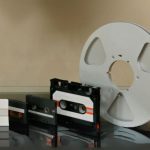 Technology
Technology  Technology
Technology  Humans
Humans 10 Everyday Human Behaviors That Are Actually Survival Instincts
 Animals
Animals 10 Animals That Humiliated and Harmed Historical Leaders
 History
History 10 Most Influential Protests in Modern History
 Creepy
Creepy 10 More Representations of Death from Myth, Legend, and Folktale
 Technology
Technology 10 Scientific Breakthroughs of 2025 That’ll Change Everything
 Our World
Our World 10 Ways Icelandic Culture Makes Other Countries Look Boring
 Misconceptions
Misconceptions 10 Common Misconceptions About the Victorian Era
 Mysteries
Mysteries 10 Strange Unexplained Mysteries of 2025
 Miscellaneous
Miscellaneous 10 of History’s Most Bell-Ringing Finishing Moves
 Technology
Technology Top 10 Everyday Tech Buzzwords That Hide a Darker Past
 Humans
Humans 10 Everyday Human Behaviors That Are Actually Survival Instincts
 Animals
Animals 10 Animals That Humiliated and Harmed Historical Leaders
Who's Behind Listverse?

Jamie Frater
Head Editor
Jamie founded Listverse due to an insatiable desire to share fascinating, obscure, and bizarre facts. He has been a guest speaker on numerous national radio and television stations and is a five time published author.
More About Us History
History 10 Most Influential Protests in Modern History
 Creepy
Creepy 10 More Representations of Death from Myth, Legend, and Folktale
 Technology
Technology 10 Scientific Breakthroughs of 2025 That’ll Change Everything
 Our World
Our World 10 Ways Icelandic Culture Makes Other Countries Look Boring
 Misconceptions
Misconceptions 10 Common Misconceptions About the Victorian Era
 Mysteries
Mysteries 10 Strange Unexplained Mysteries of 2025
 Miscellaneous
Miscellaneous 10 of History’s Most Bell-Ringing Finishing Moves
10 Futuristic Fungal Technologies
Fungi are miraculous. They provide us with food, alcohol, medicine, and the essential decomposition that keeps life going. And yet, their potential may be far greater. Fungi can be made into computer chips, bio-batteries, circuit boards, insulation, self-repairing building materials, and reactive clothing. They can even devour plastic, absorb heavy metals, and clean pollution.
Make no mistake: the future is fungal.
Related: Top 10 Ancient Finds That Will Surprise You Today
10 Computers
Not only are shiitake mushrooms delicious—they might also be the next step in computing. In October 2025, researchers at Ohio State University announced that these mushrooms could serve as organic memory devices. Mature fungi were dried for preservation and attached to custom circuits. The mushrooms were then exposed to varying electrical currents. The team found that mushroom-based RAM could switch between electrical states at the astounding speed of 5,850 per second with 90% accuracy, mimicking the action of semiconductors. The mushrooms performed less well at higher frequencies, but stability increased when individual mushrooms were connected together, mirroring the behavior of human neurons.
Lead researcher John LaRocco notes that fungal electronics are not entirely new, but their potential for sustainable computing is revolutionary. Fungal materials are inexpensive, biodegradable, and require less energy to produce. They could eliminate electronic waste and reduce dependence on rare earth minerals. While fungal chips are currently slower than silicon, researchers envision them being used in aerospace research, edge computing, and wearable devices.[1]
9 Plastic-Eating Fungi
We have a plastic problem. A century ago, plastic was introduced as a cheap, durable miracle material. Now it chokes landfills and decimates ocean life. We produce more than 440 million tons (400 million metric tons) of plastic every year, and a huge percentage becomes waste. Fungi may offer a solution.
In 2011, undergraduates from Yale University made a remarkable discovery in the Ecuadorian Amazon rainforest: a mushroom that could survive by eating plastic. Pestalotiopsis microspora can live on polyurethane as its sole source of energy and thrive in both oxygen-rich and oxygen-poor environments, such as landfills.
It’s not alone. In 2017, scientists found another species, Aspergillus tubingensis, that can break down polyurethane within weeks. In 2024, researchers discovered Parengyodontium alum living in the Great Pacific Garbage Patch, capable of digesting UV-exposed polyethylene. Collectively, these fungi point to a future where plastic pollution could be naturally broken down rather than persisting for centuries.[2]
8 Insulation
Fungi may also hold the key to greener homes. Grown on agricultural waste, fungal root-like threads—or mycelium—can be shaped into foam-like blocks that rival fiberglass or mineral wool for insulation. These blocks are lightweight, naturally fire-resistant, and have impressive acoustic and thermal properties. They’re also carbon negative, fully biodegradable, and require far less energy to produce.
In Alaska, where temperatures can range from −78°F (−61°C) in winter to 100°F (38°C) in summer, mycologist Philipe Amstislavski has been developing fungal insulation using native species grown on wood pulp. Traditional insulation methods, he notes, are “basically wrapping your house in a plastic bag.” His team’s mycelium-based materials have endured nine years of testing without mold, providing breathable insulation that improves air quality. Further research is underway to determine long-term durability, but results so far look promising.[3]
7 Mycoremediation
Fungi can devour pollution. The process, known as mycoremediation, relies on digestive enzymes secreted by mushrooms to break down toxic chemicals such as pesticides and petrochemicals. They can even absorb heavy metals like lead, mercury, and cadmium.
The concept dates back to 1963, when The Journal of Phytopathology published research on white-rot fungi’s ability to degrade chlorophenols. That same year, U.S. government researchers Catherine Duncan and Flora Deverall explored similar uses for wood-decaying mushrooms.
Modern studies have confirmed fungi’s effectiveness. Researcher Danielle Stevenson’s Los Angeles brownfield projects saw hydrocarbon pollutants drop by 50% in three months and heavy metals reduced by up to 50% within a year. Oyster mushrooms, meanwhile, have been used to clean diesel spills and filter contaminated runoff. Though the fungi themselves become toxic and can’t be eaten, their ability to restore polluted land is extraordinary.[4]
6 Leather
Processing animal leather is expensive and environmentally damaging, while most faux leathers rely on fossil fuels. Fungi offer a cleaner alternative. The secret lies in the mycelium—the thread-like root structure—which forms dense mats on organic substrates. Once compressed and treated, these mats resemble leather in texture and durability. Some even “heal” small punctures when soaked in a nutrient bath that reactivates the living fibers.
Mycelium leather is biodegradable and cost-effective. It’s produced from agricultural waste such as corn husks and sawdust, avoiding the toxins and water waste of tanning. Studies show its carbon footprint is over 90% lower than traditional leather. Major brands like Hermès, Stella McCartney, and Calvin Klein have partnered with companies producing these fungal leathers, such as MycoWorks and Bolt Threads. The global mushroom-leather market hit $12 million in 2024 and could exceed $300 million by 2033.[5]
5 Batteries
In January 2025, Swiss researchers announced a biodegradable bio-battery powered entirely by fungi. The 3D-printed device uses the complementary metabolism of two fungal species: yeast at the anode and white-rot fungus at the cathode. When sugars are added, the yeast’s metabolism produces electrons that flow to the white-rot fungus, generating an electric current.
To build the batteries, fungal cells are mixed with carbon particles and ink to enhance conductivity, then printed layer by layer. Once dried, they can be activated simply by adding water and nutrients. When spent, they can be composted without harming the environment.
While these batteries currently produce a modest 0.3 volts—enough to power sensors for days—they could play a vital role in environmental monitoring and low-power electronics.[6]
4 Insoles
Foot fungus is usually something to avoid—or is it? Fungal insoles represent cutting-edge biowearable technology made from mycelium. Unlike standard insoles, these smart fungal versions can detect changes in moisture, load, and movement while generating their own electricity.
Because fungal networks naturally conduct electrical signals, they can sense pressure and motion, adjusting in real time. This has potential applications in sports performance, posture correction, and even medical diagnostics for conditions such as Parkinson’s disease.
The insoles are made by allowing Pleurotus ostreatus (oyster mushroom) to colonize a substrate. Traditional insoles made of petrochemical foams can’t compete with their sustainability—or their self-repairing ability. The biggest challenge remains keeping the fungi moist enough to function without soaking the wearer’s shoes.[7]
3 Keep Food Fresh Using Fungi
Want to keep food fresh? Try fungus. In 2025, researchers at the University of Maine created a waterproof, food-safe film from edible mushrooms that could replace single-use plastics.
The team combined turkey tail mushrooms with a nutrient-rich solution of plant fibers, applying the mixture to denim, polyester, felt, and paper. After four days, the treated materials repelled water, oil, and grease, while the untreated samples absorbed moisture immediately.
The coating, made of Trametes versicolor mycelia, forms a layer as thin as a coat of paint but just as effective. According to researcher Catherine Howell, the cellulose–mycelium blend can even be sprayed onto 3D surfaces like cups or trays. In the future, eco-friendly fungal coatings may protect food packaging without plastic waste.[8]
2 Circuit Boards
Every day, the world produces more than 140,000 tons of electronic waste. To combat that, researchers at Austria’s Johannes Kepler University explored using fungi to make biodegradable circuit boards.
While studying insulation materials, a PhD student discovered that the bracket fungus Ganoderma lucidum grows a tough “skin” over its substrate. When peeled and dried, the skin forms flexible, heat-resistant sheets resembling parchment. Researchers used gold and copper layers to print circuits onto the fungal skin, then etched away the excess with lasers, leaving only conductive pathways.
These mushroom-based boards can endure temperatures above 392°F (200°C) and decompose safely after disposal. They offer a sustainable alternative to traditional plastic-based electronics—and could help reduce our growing e-waste crisis.[9]
1 Self-Healing Concrete
Concrete cracks. Even small fissures can cause catastrophic failures in infrastructure. In 2018, researchers from Rutgers and Binghamton Universities proposed a surprising fix: a fungus that repairs concrete from within.
By embedding dormant spores of Trichoderma reesei and nutrients into the concrete mix, the team discovered that water and oxygen entering a crack reawaken the fungus. As it grows, it precipitates calcium carbonate (CaCO₃), sealing the damage before going dormant again.
The technique can repair cracks up to 0.2 inches (5 mm) wide—larger than any bacterial method to date. Because fungi are more resilient than bacteria, they can survive in harsh, dry concrete for years. If adopted on a large scale, fungal self-healing concrete could extend the lifespan of bridges, dams, and power plants, dramatically reducing maintenance costs.[10]








